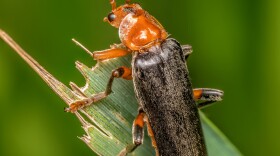All spiders can make silk. Made of fibrous proteins, it’s one of the most versatile materials in the world and is used by arachnids for a variety of purposes. Transportation. Making an egg sac. Courtship. And of course, many spiders use silk to make a web to capture their prey.
While some silk slingers make large, elaborate webs, there’s one species that might at first appear a bit lazy in the web-building department. But what it seemingly lacks in motivation is more than made up for with style.
The web of the female Bolas Spider consists of one to three single strands of silk, stretched from one point to another. Hanging from one of the wires, sort of like a tightrope walker balancing on the middle of their rope, the spider will spin a single strand with a large, sticky glob or two at the end.
It sort of looks like she’s holding a yo-yo that’s at the end of its string.
Armed with this medieval-looking weapon, she’s ready to hunt …and more specifically, hunt for male moths.
But to up her odds of success, she’s got an amazing trick up her silken sleeve.
To attract her prey, the bolas spider produces a scent that mimics the sex pheromones emitted by the female of one or more moth species. Falling for this deceptive bouquet, love-struck male moths approach the waiting spider.
Once a moth is within range, she’ll start swinging her gooey glob-on-a-string in a circular motion at a passing moth in hopes that her weapon will connect and stick.
If she’s successful, she’ll simply reel in her catch, deliver a venomous bite, and wrap up her prey for dinner.





